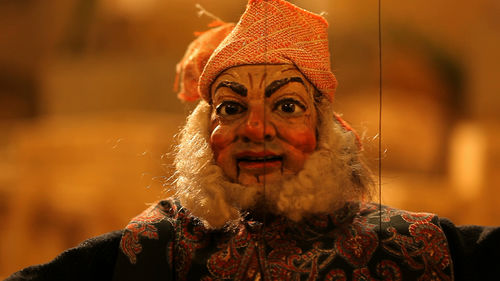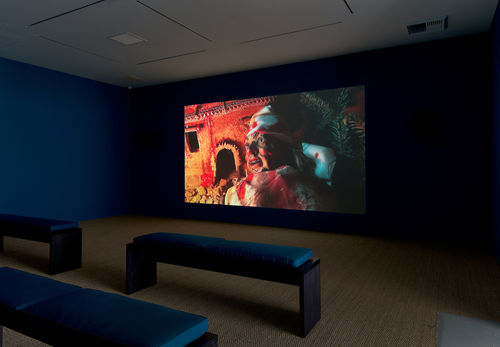
Hammer Projects: Wael Shawky
- – This is a past exhibition
Hammer Projects: Wael Shawky is organized by guest curator Cesar Garcia.
Biography
Wael Shawky was born in 1971 in Alexandria, Egypt, where he lives and works today. He studied fine art at the University of Alexandria before receiving his MFA from the University of Pennsylvania in 2000. His work has been included in major international exhibitions, including the 2013 Sharjah Biennial; Documenta 13, Kassel, Germany (2012); the ninth Gwangju Biennial, Gwangju, South Korea (2012); the SITE Santa Fe Biennial (2008); the ninth International Istanbul Biennial (2005); and the fiftieth Venice Biennale (2003). Shawky has had solo exhibitions at the KW Contemporary Art Institute, Berlin (2012); Nottingham Contemporary, Nottingham, England (2011); the Walker Art Center, Minneapolis (2011); the Delfina Foundation, London (2011); Cittadellarte-Fondazione Pistoletto, Biella, Italy (2010); Townhouse Gallery, Cairo (2005, 2003); and other venues. He has received various awards, including the Award for the Filmic Oeuvre created by Louis Vuitton and Kino der Kunst (2013); Abraaj Capital Art Prize (2012); Kunstpreis der Schering Stiftung (2011); and the Grand Prize, 25th Alexandria Biennale, Alexandria, Egypt (2009). In 2011 he was an artist-in-residence at the Center for Possible Studies, Serpentine Gallery, London. Shawky is the founder of MASS Alexandria, a studio program for young artists.
Essay
By Cesar Garcia
Walter Benjamin once wrote that “a chronicler who recites events without distinguishing between major and minor ones acts in accordance with the following truth: nothing that has ever happened should be regarded as lost for history.”[1] It is difficult to believe, however, that the truth Benjamin speaks of has been a driving force in the construction of the historical narratives of our time. History making entails not only piecing together but also tearing apart; it is as much deconstruction as it is construction, encompassing both inscription and erasure. Decisions about what events are deemed significant enough to be remembered are made by dominant stakeholders, and what emerges from this process, the faux construct of a singular “History,” constitutes only a brutally fragmented account that bears the scars left behind by multiple excisions.
The popularly known history of Western civilization embodies this type of epistemic violence, as can be seen in its narratives of encounters between the West and other civilizations. The Crusades, the military expeditions to the Holy Land undertaken by European Christians between the eleventh and the thirteenth century, are one such instance of cultural contact. The events that unfolded have been documented in terms of key battles, important sieges, and pivotal transfers of power between Christian and Muslim armies. The real intentions fueling the Crusades remain unclear, however, and contradictory historical records have both Western and Arab historians contesting this history today. What is clear is that one of the principal goals for both Christians and Muslims was to keep or regain control of Jerusalem, and as current events show, the outcome of that struggle is yet to be determined.
In 1984 the Lebanese writer Amin Maalouf published The Crusades through Arab Eyes. Written as an accessible “true-life novel,” the book draws from the chronicles and testimonies of Arab writers and historians to present what the author calls a “neglected point of view” regarding the Crusades.[2] Avoiding an excessive listing of dates and bibliographic citations, this narrative retelling of the Crusades provides an on-the-ground look at the various individuals involved on both sides of the conflict, the decisions that they made, and the impact that they continue to have on Western-Arab relations. Rather than taking an explicit position, Maalouf lays out a series of occurrences documented by Arab historians that allow readers to navigate the side streets and back alleys of official histories. His account sheds light on the atrocities committed by the Christian armies as well as on the corruption, betrayal, and backroom deals of Arab leaders struggling to hold on to power.
In 2010 the Egyptian artist Wael Shawky took Maalouf’s book as a point of departure for one of his most ambitious works to date, Cabaret Crusades. This ongoing project—encompassing drawings, objects, installations, and films—was conceived by the artist as a translation of The Crusades through Arab Eyes into images to be encountered by viewers in multiple forms. Treating the book as fact, Shawky attempts to present this revisionist narrative from a distanced perspective, carefully avoiding the representation of any singular point of view and instead offering viewers a complexly interwoven recollection inspired by the voices that are so often silenced in the production of histories. Three films make up the anchoring component of Cabaret Crusades: The Horror Show File (2010), The Path to Cairo (2012), and The Secrets of Karbala (in production). At the Hammer Museum, Shawky is presenting the first part of this film trilogy, which focuses on the short period from 1095 to 1099, often referred to as the time of the First Crusade.
Working closely with Cittadellarte–Fondazione Pistoletto in Biella, Italy, Shawky was able to secure the loan of more than 120 two-hundred-year-old marionettes from the Lupi collection in Turin, Italy. The artist made period-specific costumes for the marionettes, built intricate realistic sets, created a score, and wrote a script in Arabic that narrates these early pivotal years of the conflict. The result is a half-hour film that takes viewers across the various places in Europe and the Middle East that set the stage for the beginning of the Christian holy war. The marionettes, molded with ceramic heads and limbs, take on the roles of various historical figures as well as everyday persons. Unlike characters portrayed by actors, who often project their own personalities onto a scripted role, the characters in Shawky’s film appear distant and timeless at once, reinforcing the artist’s attempts to prevent individual perspectives and opinions from dominating the telling of this tragic story. As the marionettes move across the screen, the strings that connect them to the puppeteers create a complex web that poetically visualizes the systems of manipulation and control that are so poignantly embedded in the events that unfold in each subsequent shot. Rather than presenting the films as isolated projections, Shawky carefully constructs installation environments for them, drawing attention to history’s relationship to the staged and the theatrical.
The Horror Show File (2010) begins with Pope Urban II’s passionate speech delivered at the Council of Clermont in November 1095. Although no actual transcript of the speech exists, five distinct versions of it surfaced in the years following the Christian siege of Jerusalem in 1099. It is widely accepted that in this speech Urban II spoke of a new kind of war that would offer remission for their sins to those who were willing to help expel the “vile races” from Christian lands.[3] The film then traces the early recruitment of soldiers and takes us to both major and minor battles, oftentimes depicting extremely violent realities that are layered with a surrealistic atmosphere on the screen. Shawky’s film makes a linear historical narrative hard to grasp as significant and quotidian events are condensed into moving images, giving shape to a kaleidoscopic set of situations forged by encounters between leaders, conversations between emissaries, and the massacres fueled by the radical beliefs of Christian extremists desperately trying to reclaim their dominance in the world. The Horror Show File comes to an end with the fall of Jerusalem to the Christian armies in 1099, a devastating moment for the Arab world that would set the stage for future conflicts, chronicled in subsequent chapters of Shawky’s project.
It would take almost a half century after the fall of Jerusalem for the Muslim armies to come together to call for a jihad to reclaim it, and even after Saladin’s later triumph, it seems that the battle for the Holy Land continues with no end in sight. As characters are introduced in Shawky’s films and as he takes us to places like Aleppo and Damascus, it becomes difficult not to hear the echoing effects of these histories in the current moment. Although he has stated on various occasions that Cabaret Crusades was not conceived with explicit political intentions, the rhetoric spread by the various factions portrayed in the films and the violent actions that occur on-screen seem too familiar and at times chillingly personal. In presenting these accounts in such a playful yet visceral way, Shawky perhaps comes close to achieving the recollection of the past that Benjamin envisioned: “To articulate the past historically does not mean to recognize it ‘the way it really was.’ It means to seize hold of a memory as it flashes up at a moment of danger.”[4] As countries across the Middle East rise up to demand a more promising way of being, and as fears of religious extremism continue to fuel distrust and violence while making the possibility of cultural understanding seem ever more remote, Shawky’s project forces us to step back and consider the many actors and factions that have molded our world and the intentions behind their actions.
Notes
1. Walter Benjamin, “Theses on the Philosophy of History,” in Illuminations: Essays and Reflections, ed. Hannah Arendt, trans. Harry Zohn (New York: Schocken, 1969), 254.
2. Amin Maalouf, The Crusades through Arab Eyes (New York: Schocken, 1989), xii.
3. “Urban II: Speech at Council of Clermont, 1095; Five Versions of the Speech,” Internet Medieval Sourcebook, Fordham University Center for Medieval Studies, http://www.fordham.edu/halsall/source/urban2-5vers.html.
4. Benjamin, “Theses,” 255.
Hammer Projects is a series of exhibitions focusing primarily on the work of emerging artists.
Hammer Projects is made possible by a major gift from The Horace W. Goldsmith Foundation.
Generous support is provided by the Los Angeles County Board of Supervisors through the Los Angeles County Arts Commission and Susan Bay Nimoy and Leonard Nimoy.
Additional support is provided by Good Works Foundation and Laura Donnelley; the Department of Cultural Affairs, City of Los Angeles; the Decade Fund; and the David Teiger Curatorial Travel Fund.













